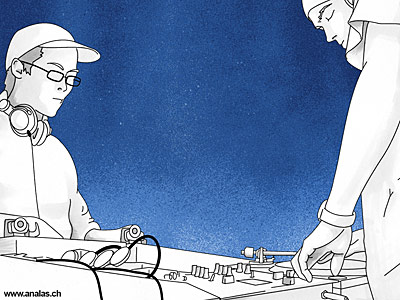
Literature, music and rap keep Romansh language alive

Many American and French rappers invent their own vocabulary, but Romansh hip-hop groups and singers use the language of their ancestors.
What is happening with music is not a new phenomenon. Romansh literature underwent a revival a century ago and helped the emerging Romansh identity to flourish.
The language of Romansh, with its roots in the southeastern Swiss canton of Graubünden, has a long written tradition, including Biblical texts dating from the 16th century.
But it was not until the 19th century that large volumes of Romansh literature began to appear, bolstered by the need to defend a disappearing language.
“This literature helped form a nation,” Clau Solèr, a professor of Romansh at Geneva University, told swissinfo.
Notable poets of the period include Caspar Muoth, Gion Antoni Huonder and Peider Lansel.
Since then Romansh literature has matured, although the need for preservation remains strong. “Each author sees him or herself as a defender of the language,” said Solèr.
The professor says that over the past 50 years Romansh literature has turned to more modern topics and literary quality has become more important.
Current stars of the scene include Rut Plouda, Leo Tuor and the late Flurin Spescha. “This type of literature is totally modern and sometimes difficult. It worries less about reader expectations and is more concerned with the literary desire of the author,” said Solèr.
Fragmented
It is, however, a fragmented literature: each author writes in their own idiom as there are five variants of Romansh.
The controversial standardised version of the language, Rumantsch Grischun (RG), is not widely used.
“Flurin Spescha was the only author to use RG, the others prefer to use their idiom because they see it as stronger instrument for authenticity and identification. There is therefore a counter-movement [to RG],” explained Solèr.
Needless to say, translation into German and French plays a major role in helping these texts gain recognition in the rest of Switzerland – and beyond.
Tradition also plays its part in music. As in many Swiss rural and mountainous regions, choir singing is very popular in Graubünden. Choir master Hans Erni (1867-1961), is regarded by many as the father of Romansh song.
These days Romansh is present in many musical genres. The most well known Romansh singer is Corin Curschellas, who also sings in Swiss German and English. She offers a mix of traditional and modern sounds.
Public service Radio Romansh (RR) is a great supporter of homegrown music and offers artists recording facilities. One of RR’s latest discoveries is the young Olivia Spinatsch, who is both a singer and a journalist.
Rapping in Romansh
The group Bulais is known for its pop rock, but it is the rappers Liricas Analas who have made the most recent breakthrough. They have produced two albums since 2000 and have become well known in the Swiss hip-hop scene.
Romansh music also looks outwards. In 2005 a double album of Beatles hits in Romansh – sung by a number of artists, not all of them native speakers – came onto the market.
“Help” thus becomes “Agid”, Strawberry Fields Forever – “Frajas giardin” and “All You Need its Love” – “Tut è spir amur”…
Idioms also reign supreme in music, which can make it difficult for Romansh songs to gain acceptance across Graubünden.
“It is very difficult for artists to pass from one valley to another, but it’s not as difficult to reach [the German-speaking city of] Zurich,” Ursin Lutz, editor of the monthly youth magazine, Punts, told swissinfo.
Lutz says that he has noticed a cultural revival among young people both in Romansh literature – his magazine also publishes young writers – and in music.
“There is more motivation among young people and especially more pride,” explained Lutz.
“Young people want to distinguish themselves from the masses. Romansh allows for this, this feeling of belonging to a particular culture.”
swissinfo, Bernard Léchot
This year’s autumn parliamentary session runs in Romansh-speaking Flims, in the southeastern canton of Graubünden, from September 18-October 6.
As well as an influx of members of the political, economics and cultural sectors, the region of Surselva around Flims is expecting an increase in visitors.
To mark the event, swissinfo is publishing a series of articles and a dossier on Romansh, delving into the past present and future of Switzerland’s threatened fourth national language.

In compliance with the JTI standards
More: SWI swissinfo.ch certified by the Journalism Trust Initiative




























You can find an overview of ongoing debates with our journalists here . Please join us!
If you want to start a conversation about a topic raised in this article or want to report factual errors, email us at english@swissinfo.ch.